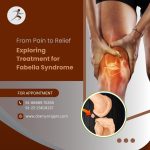Knee pain can be an alarming and frustrating experience for many people. Whether you're an athlete, an active individual, or someone just going about daily life, knee pain can significantly impact your quality of life. One of the most common dilemmas people face when dealing with knee pain is understanding the underlying cause. Is it arthritis, or is something torn like a ligament or meniscus? Proper diagnosis is key to effective treatment and recovery. In this article, we’ll explore the differences between knee pain caused by arthritis and injuries such as ligament or meniscal tears, and when it’s time to consult a knee specialist in Mumbai.
Understanding the Anatomy of the Knee
Before diving into the causes of knee pain, it's essential to understand the basic anatomy of the knee. The knee is a complex joint that connects the thigh bone (femur) to the shinbone (tibia). The patella (kneecap) protects the knee joint at the front. Several ligaments, including the ACL (anterior cruciate ligament), PCL (posterior cruciate ligament), MCL (medial collateral ligament), and LCL (lateral collateral ligament), provide stability to the joint. The meniscus, a C-shaped piece of cartilage, acts as a cushion between the bones.
Given the knee's complexity, it’s no surprise that this joint is susceptible to a range of problems, including arthritis and tears in the ligaments or meniscus. An accurate diagnosis is best provided by an orthopaedic doctor in Mumbai, especially when the pain persists.
Arthritis: The Wear and Tear Condition
Osteoarthritis (OA) is the most common type of arthritis affecting the knee. It is primarily a wear-and-tear disease that happens when the protective cartilage that cushions the ends of the bones wears down over time. Arthritis is common in older adults but can occur in younger people as well, particularly those with a history of knee injuries or overuse.
Symptoms of Knee Arthritis:
- Chronic pain: The pain tends to develop gradually and worsens over time. It’s typically worse in the morning or after periods of inactivity.
- Stiffness: Many people with arthritis report stiffness, especially in the morning, which eases as the day progresses.
- Swelling: Fluid buildup around the knee joint may cause visible swelling.
- Crunching sensations: You may feel or hear a grating sensation when you move your knee due to the loss of smooth cartilage surfaces.
- Limited range of motion: Arthritis may reduce your ability to move the knee fully.
While arthritis is a progressive condition, its symptoms can often be managed through various treatments, including physical therapy, medications, and in some cases, surgery. If you're experiencing persistent knee pain, a knee surgeon in Mumbai can assess the extent of the damage and recommend appropriate treatment.
Ligament and Meniscal Tears: Acute Injuries
Unlike arthritis, which develops over time, ligament and meniscal tears are usually the result of an acute injury, such as twisting the knee, sudden impacts, or overuse in sports.
Ligament Tears:
Ligament injuries, especially to the ACL, are among the most common causes of knee pain in athletes. These injuries usually occur when there is a sudden change in direction, landing awkwardly from a jump, or receiving a direct blow to the knee.
Symptoms of Ligament Tears:
- Sudden, sharp pain: Pain from a ligament tear is often immediate and intense, unlike arthritis which develops gradually.
- A “popping” sound or sensation: Many people with a ligament injury report hearing or feeling a pop when the injury occurs.
- Instability: You may feel that your knee is giving way or unable to support your weight.
- Swelling: Swelling often develops within a few hours of the injury.
- Limited movement: It becomes difficult to bend or straighten the knee after a ligament tear.
If you suspect a ligament injury, it’s crucial to seek help from an orthopaedic doctor in Mumbai who specializes in sports injuries. Early diagnosis and treatment can prevent long-term damage.
Meniscus Tears:
The meniscus is a piece of cartilage that acts as a shock absorber between your femur and tibia. A torn meniscus can happen when you twist or rotate your knee while bearing weight on it, such as during a squat or while playing sports.
Symptoms of Meniscus Tears:
- Pain: Pain is usually localized on the inside or outside of the knee, depending on which part of the meniscus is torn.
- Swelling and stiffness: Like ligament tears, a torn meniscus can cause swelling and stiffness in the knee.
- Locking or catching sensation: You might feel as though your knee is locked in place or catches when you try to move it.
- Difficulty squatting: People with a meniscus tear may struggle to fully squat or kneel.
Meniscus tears can often be treated conservatively, but in more severe cases, surgery may be required. Consulting a knee specialist in Mumbai can help determine whether surgical intervention is needed.
Diagnosing Knee Pain: When to Seek Help
Whether your knee pain is caused by arthritis or something torn, early diagnosis and treatment are critical to preventing long-term damage and getting back to your normal activities.
When to Consult a Doctor:
- Persistent pain: If your knee pain lasts for more than a few days and doesn't improve with rest, it's time to see an orthopaedic doctor.
- Swelling: If your knee swells significantly after an injury or gradually increases in size, seek medical attention.
- Difficulty bearing weight: If you cannot put weight on your knee or it feels unstable, consult a knee specialist.
- Limited range of motion: If you cannot fully straighten or bend your knee, it’s important to get an evaluation.
A knee surgeon in Mumbai or a specialized orthopaedic doctor in Mumbai can use various diagnostic tools, such as X-rays or MRIs, to determine the underlying cause of your knee pain.
Treatment Options for Knee Pain
The treatment approach for knee pain depends on whether the cause is arthritis or an injury like a ligament or meniscus tear.
Arthritis Treatment:
- Lifestyle modifications: Reducing activities that put stress on the knee can help manage symptoms.
- Physical therapy: Exercises that strengthen the muscles around the knee can improve stability and function.
- Medications: Over-the-counter pain relievers and anti-inflammatory medications can help control arthritis pain.
- Injections: Corticosteroid injections or hyaluronic acid injections may provide temporary relief.
- Surgery: In advanced cases, a knee replacement might be necessary. A knee surgeon in Mumbai can discuss whether surgery is appropriate for your case.
Ligament and Meniscus Tear Treatment:
- Rest and physical therapy: Minor tears can often heal with rest, ice, and physical therapy to regain strength and stability.
- Bracing: A knee brace may help stabilize the joint during the healing process.
- Surgery: Severe ligament and meniscus tears may require arthroscopic surgery to repair the damage. A knee specialist in Mumbai can help guide you through your surgical options.
Conclusion
Knee pain can stem from various causes, but understanding whether it’s due to arthritis or something torn, like a ligament or meniscus, is the first step towards effective treatment. Consulting a knee surgeon in Mumbai or an experienced orthopaedic doctor in Mumbai can help ensure you receive the appropriate care, whether through conservative management or surgical intervention. Don’t let knee pain control your life – seek expert help and get back to the activities you love.




